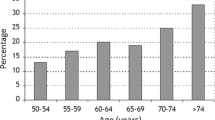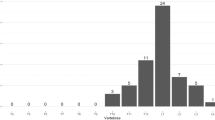Abstract
The aims of this study were to ascertain vertebral deformity prevalence in elderly men and women and to describe the association between bone mineral density (BMD) at the lumbar spine and femoral neck, severity of spinal degenerative disease and vertebral deformity prevalence. We performed standardized spinal radiographs in a random sample of 300 elderly men and women participating in the Dubbo Osteoporosis Epidemiology Study, a population-based study of fracture risk factors. Radiographs were read independently by masked observers for the prevalence of vertebral deformity and severity of osteophytosis. BMD was measured by dual-energy X-ray absorptiometry. The prevalence of vertebral deformities was critically dependent on the criterion used. The less strict criteria seemed to overestimate deformities at either end of the spine region analysed. However, irrespective of the criterion used, prevalence of deformity was higher in men than in women (25% vs 20% for the 3 SD criterion, 17% vs 12% for the 4 SD criterion and 27% vs 25% for the 25% criterion). Femoral neck BMD was more strongly associated with vertebral deformities than spinal BMD for the 25% criterion (OR/SD change in BMD 1.39 (p=0.02) vs 1.20 (p=0.19)), 3 SD criterion (OR/SD change in BMD 1.45 (p=0.01) vs 1.10 (p=0.34)) and 4 SD criterion (OR/SD change in BMD 1.98 (p=0.0002) vs 1.68 (p=0.008)). BMD was also more strongly associated with biconcave deformities than either wedge or crush deformities and more so in men than in women. Severity of spinal osteophytosis was not associated with vertebral deformity. In conclusion, femoral neck BMD is at least equivalent to the lumbar spine BMD in strength of association with prevalent vertebral fractures. Spinal osteophytosis falsely elevates BMD without a concomitant decrease in fracture risk, indicating that any interpretation of spinal BMD needs to be adjusted for osteophytosis. These findings support the use of femoral neck bone densitometry in older men and women. Moreover, these data indicate that current criteria for radiological assessment of vertebral deformity are sufficiently loose to include a substantial proportion of non-fractures in the elderly, with important implications for the design of clinical trials. However, irrespective of the criterion used, vertebral deformities in men are at least as common, if not more so, than in women, suggesting that vertebral osteoporotic fractures are overlooked in men.
Similar content being viewed by others
References
Melton LJ, Kan SH, Frye MA, et al. Epidemiology of vertebral fractures in women. Am J Epidemiol 1989;129:1000–11.
Cooper C, O'Neill T, Silman A. The epidemiology of vertebral fractures. Bone 1993;14:S89–97.
Eastell R, Cedel SL, Wahner HW, Riggs BL, Melton LJ III. Classification of vertebral fractures. J Bone Miner Res 1991;6:207–13.
Ettinger B, Black DM, Nevitt MC, et al. Contribution of vertebral deformities to chronic back pain and disability. J Bone Miner Res 1992;7:449–56.
Ross PD, Ettinger B, Davis J, Melton LJ, Wasnich RD. Evaluation of adverse health outcomes associated with vertebral fractures. Osteoporosis Int 1991;1:134–40.
Spector TD, McCloskey EV, Doyle DV, Kanis JA. Prevalence of vertebral fracture in women and the relationship with bone density and symptoms. J Bone Miner Res 1993;8:817–22.
Zetterburg C, Mannius S, Mellstrom D, Rundgren A, Astrand K. Osteoporosis and back pain in the elderly. Spine 1990;15:783–6.
Orwoll ES, Oviatt SK, Mann T. The impact of osteophytic and vascular calcifications on vertebral mineral density measurements in men. J Clin Endocrinol Metab 1990;70:1202–7.
Reid IR, Evans MC, Ames R, Wattie DJ. The influence of osteophytes and aortic calcification on spinal mineral display in postmenopausal women. J Clin Endocronol Metab 1991 ;72:1372–4.
Masud T, Langley S, Wiltshire P, et al. Effect of spinal osteophytosis on bone mineral density measurements in vertebral osteoporosis. BMJ 1993;307:172–3.
Jones G, Nguyen T, Sambrook PN, et al. A longitudinal study of the effect of spinal degenerative disease on bone density in the elderly. J Rheumatol 1995;22:921–5.
Simons LA, McCallum J, Simons J, et al. The Dubbo study: an Australian prospective community study of the health of elderly. Aust NZ J Med 1990;20:783–9.
Nguyen T, Sambrook P, Kelly PJ, et al. Prediction of osteoporotic fractures by postural instability and bone density. BMJ 1993;307:1111–5.
Jones G, Nguyen T, Sambrook PN, et al. Symptomatic fracture incidence in elderly men and women: the Dubbo Osteoporosis Epidemiology Study (DOES). Osteoporosis Int 1994;4:277–82.
Lord SR, Sambrook PN, Gilbert C, et al. Postural stability, falls and fractures in the elderly: results from the Dubbo Osteoporosis Epidemiology Study. Med J Aust 1994;160:684–91.
Jones G, Nguyen T, Sambrook P, et al. Progressive femoral neck bone loss in the elderly: longitudinal findings from the Dubbo Osteoporosis Epidemiology Study. BMJ 1994;309:691–5.
Nguyen T, Kelly PJ, Sambrook PN, et al. Interaction of lifestyle factors and bone density in the elderly: implications for osteoporosis prevention. J Bone Miner Res 1994;9:1339–46.
National Osteoporosis Foundation Working Group. Report: assessing vertebral fractures. J Bone Miner Res 1995;10:518–23.
Pogrund H, Makin M, Robin G, Menczel J, Steinberg R. Osteoporosis in patients with fractured femoral neck in Jerusalem. Clin Orthop 1977;124:165–72.
Harma M, Heliovaara M, Aromaa A, Knekt P. Thoracic spine compression fractures in Finland. Clin Orthop 1986;205:188–94.
O'Neill TW, Varlow J, Felsenberg D, Silman AJ. Sex and geographic influences on the prevalence of vertebral deformity [abstract], J Bone Miner Res 1994;8(Suppl 1):B166.
Cooper C, Atkinson EJ, O'Fallon WM, Melton LJ. Incidence of clinically diagnosed vertebral fractures: a population-based study in Rochester, MN, 1985–1989. J Bone Miner Res 1992;7:221–7.
Dequeker J. The relationship between osteoporosis and osteoarthritis. Clin Rheum Dis 1985;11:271–95.
Author information
Authors and Affiliations
Rights and permissions
About this article
Cite this article
Jones, G., White, C., Nguyen, T. et al. Prevalent vertebral deformities: Relationship to bone mineral density and spinal osteophytosis in elderly men and women. Osteoporosis Int 6, 233–239 (1996). https://doi.org/10.1007/BF01622740
Received:
Accepted:
Issue Date:
DOI: https://doi.org/10.1007/BF01622740




